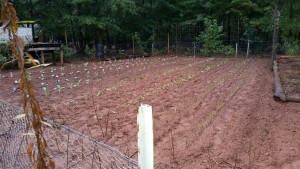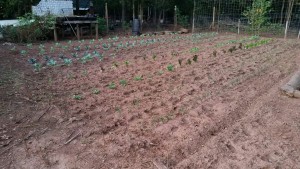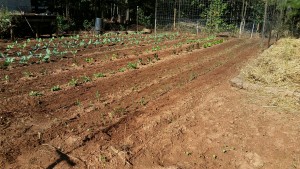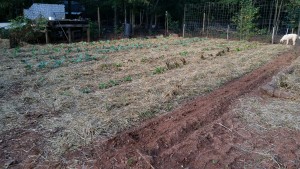http://www.motherearthnews.com/homesteading-and-livestock/raising-pigs/american-guinea-hog-zm0z15onzmat.aspx
Few animals are as useful as pigs on the homestead. They have provided their owners with valuable lard to cook with and flavorful meat for the table for thousands of years. To many, they represented food security through lean times, because, prior to refrigeration, pigs served as an on-the-hoof food-storage system. Pigs can also perform a number of tasks around the farm. Their rooting behavior makes them natural rototillers, and they can help control unwanted species, such as snakes and rodents.
When deciding whether pigs will work for you, don’t assume all breeds are similar. Hogs can grow into massive animals, with breeding boars tipping the scales at nearly 800 pounds, plus large sows with piglets can be dangerous for the inexperienced hand. Some breeds produce large amounts of meat (130 to 150 pounds per pig), which may be too much for a small family’s needs. A small breed such as the American Guinea hog may be the best choice for many homesteads. One Guinea hog will yield 60 to 80 pounds of pork.
This rare and storied breed has a fascinating history. One theory suggests the American Guinea hog could have a close association to the Improved Essex hog, a small British breed now extinct in the United Kingdom. DNA analysis conducted in 2014 by the Canadian Animal Genetic Resources Program, led by Dr. Yves Plante in collaboration with The Livestock Conservancy, found that the Guinea hog’s genetics consistently cluster it with the Gloucestershire Old Spots pig. Because the Old Spots and the British Improved Essex share the Old English Pig and unimproved Berkshire in their foundation, these findings support the idea that our American Guinea hog is, in fact, descended from the British Improved Essex hog, which British farmers favored because it was hardy and could feed itself by foraging.
During the Guinea hog’s heyday in the late 19th and early 20th centuries, most households were cooking with lard, and this breed produced it abundantly. As the use of lard diminished, so did the American Guinea hog’s numbers.
The breed was fairly common in the South up until the 1940s. These pigs were mainly kept on small farms and were used for meat and lard production, cross-breeding, and as yard pigs to till the garden and keep snakes away.
By the 1990s, there were fewer than 100 Guinea hogs left in the United States, and it is now considered one of the rarest heritage hog breeds.
It is an easily managed, mild-mannered small pig breed that fattens well. These are great beginners’ pigs, with sows typically reaching only 150 to 180 pounds if in good condition. Boars grow to approximately 250 pounds, although some may be a bit larger. You can expect a butchering weight of approximately 120 to 150 pounds.
Home cooks will find pastured pork from American Guinea hogs to be rich enough in fat to stay succulent in cooking, whether in the high, dry heat of grilling and roasting or in the low-and-slow, moist heat of braising and barbecuing.
Caring for a Guinea Hog
Guinea hogs are wonderfully adaptable to both cold and hot climates. During hot weather, provide ample water, shade and mud-bathing opportunities to keep the pigs comfortably cool. Move mud wallow locations every few weeks so algae and bacteria don’t build up and the water doesn’t become stagnant, which can be unhealthy for the pigs.
Hogs can handle cold weather — but not if they’re wet. They need housing to keep them dry and out of the elements. Pigs particularly like deep straw bedding (6 to 12 inches or more) and will keep their bedding areas clean of feces and urine if they have ample room to roam. The shelter should be sufficient for all the pigs in your herd to fully stretch out, up to 10 square feet per hog.
Several options are available for fencing hog enclosures. The most effective way to keep a pig inside an enclosure is to provide good food and a comfortable place to live. These essentials will prevent your pigs from wanting to escape. Effective physical barriers include welded metal hog panels secured to wooden or metal posts, which work as long as the pigs don’t dig or push under the panels.
Electric fencing for pigs is another good option, given you provide proper training for the hogs. Introduce them to the “hot wire” with a solid barrier behind it, so when they touch the live wire for the first time, they will be more likely to back away from the physical barrier rather than try to push forward through the wire. Pigs are highly intelligent and need only one or two experiences with electric fencing before they learn to avoid it. You’ll not need the solid barrier behind the hot wire after the pigs learn to respect the electric barrier. The ideal enclosure replaces the solid barrier used in training with a fence of hog panels and a line of hot wire inside the fence about 6 inches off the ground. This will deter hogs from pushing on the panels or digging under them, and is also best for enclosing piglets.
If using electric fencing alone, place one strand 6 inches off the ground, one at 12 inches and another at 18 inches. And beware: Hogs will always know if the electricity goes out before you do. Solar chargers may be a better option than hard-wired units in areas prone to power outages.
Space, Feed and Water Requirements
Pigs are kept in two types of outdoor free-range enclosures — dry lots and pasture. Dry lots are open areas where groups of pigs can range together freely. With this setup, you’ll need at least 150 square feet per animal. Include dry areas with sure footing, plenty of shade during summer heat, and shelter from the cold.
When managing hogs on pasture, you’ll need a minimum of 2 acres per pig if you don’t practice rotational grazing, but you can manage up to 10 pigs per acre with good rotational grazing practices. Much depends on your location and the quality of your pasture.
Pigs eat roughly 4 percent of their live weight daily — for instance, a 150-pound pig will require 5 to 6 pounds of high-calorie feed each day. This could include kitchen scraps, restaurant waste, purchased grain or outdated milk, for example. Even with the finest pastures, your animals will need this supplemental feed; with high-quality forage, however, you can reduce supplemental feed by up to 10 percent.
Depending on your herd size, you have two options for purchasing grain: If you have a small herd, stick with bagged food; with a larger herd, bulk purchases will be more cost-effective. Feed should be used within six months to maintain optimal nutrition.
Each Guinea hog will require 3 to 5 gallons of clean, fresh water daily. Lactating sows may require an additional 1 to 2 gallons per day. Automatic waterers, especially those that are frost-resistant, are a good option for providing ample, readily available clean water during both hot and cold weather, but aren’t required.
The biggest challenge with raising the American Guinea hog is weight control — they put on weight more easily than other breeds. Overly heavy pigs will have fertility issues and eventually will have joint problems and lameness. Monitoring food intake will be very important to keep your pigs healthy and content.
The Guinea is a social animal and will welcome a little company and a good back-scratching every day.
Pastured Pork and Lard Production
Keeping stress at a minimum is important when moving your pigs, and it’s rarely productive to try to make a pig do something it doesn’t want to do. If you’re moving pigs from one pen to an adjacent pen, food is often a successful motivator. For longer distances, desensitize the pigs to the shipping crate or trailer that you’ll use to move them ahead of time. Start by placing it in the enclosure with the pigs and feed them inside of it daily. Over several days or a week’s time, the pigs will learn to become comfortable in that space and, eventually, you can close the door behind them. If you do need to urge them forward or push them into an area, use a baffle board so that your legs are protected from potential bites or accidental grazing by tusks.
Guinea hogs are making a comeback, thanks to the increasing demand for pastured pork and the rising popularity of charcuterie, or cured meats, such as ham, bacon and salami, as well as specialty cuts, such as lomo and prosciutto. Chef Craig Deihl (pictured above) of Cypress restaurant in Charleston, S.C., was one of the first chefs to embrace the Guinea as a fine charcuterie pig with an ample supply of bright-white, flavorful lard. When the pigs have grazed on acorns and forest mast, the resulting meat and lard have a beautiful, earthy flavor. Another benefit of pasturing and foraging is that the pork will have higher levels of omega-3 fats, which are essential to a healthy diet for humans.
The flavorful Guinea has become the toast of Charleston, thanks to Deihl, and its fame has spread to restaurants throughout the South, from Georgia to Virginia.
While most meat processors will have no issues with these smaller hogs, it’s wise to confer with your processor before you take your pig in for butchering. If you’re interested in charcuterie, discuss this in advance with the processor, to be sure you’ll receive caul fat and other nose-to-tail cuts from your animal, if you want them. Guinea hogs are small enough that, should you choose to have your animal returned to you whole or halved, further butchering can be finished in a home kitchen.
American Guinea Hog Resources
If you think American Guinea hogs may be a good choice for your needs, find breeders, discover more about this breed, and learn about raising pigs in general from these sources.
• The Livestock Conservancy
• American Guinea Hog Association
Books
• Butchering Poultry, Rabbit, Lamb, Goat and Pork by Adam Danforth
• Charcuterie by Michael Ruhlman and Brian Polcyn
• Homegrown Pork by Sue Weaver
• Plowing with Pigs by Oscar H. Will III and Karen K. Will
• Storey’s Guide to Raising Pigs by Kelly Klober
Jeannette Beranger, the research and technical programs manager at The Livestock Conservancy, has been a fan of the American Guinea hog ever since she kept her own herd.













